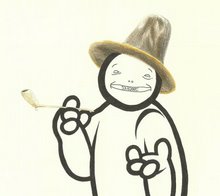✪ Science for artists and designers.
The scientific view of the world and its inner workings and principles is very precise and imaginative. For such ingenious descriptions and for things that are counter-intuitive, science could really enrich the vocabulary of artists and designers.
✪ Science for artists:
Symmetry:
In physics symmetry is a beautiful and highly advanced concept. In art we only know things like mirror-symmetry, but in physics any change to the universe that does not affect its workings, is known as a symmetry.
But there are some shocking results that came from studying symmetries.
It turns out that if you photo-shopped the universe, and tried to flip it horizontally, this mirror version doesn't work. There is some obscure particle that has no mirror-image of itself, just like a vampire.
It turns out that the world probably keeps on functioning normally if you; mirror it, and then make it run backwards, and finally, swap all particles for their associated anti-particles. But were not quite sure, its called CPT symmetry.
This brings us to:
Noethers Theorem:
Emmy Noether probably came up with the most beautiful idea ever about nature. There are some things in nature that are constant, the total amount of energy in the universe for instance. Emmy Noether saw a way to connect these conserved properties of the universe with symmetries:

- the symmetry that the laws of nature are the same at any moment in time is linked with the fact that the total amount of energy in the universe does not change.


- the symmetry that the laws of nature are the same anywhere, is linked to the fact that the total amount of momentum in the universe does not change.


- the symmetry that the laws of nature are the same in any direction from where you are, is linked to the fact that the total amount of angular momentum does not change.
Such an advanced view of symmetry could really enrich the analysis and development of artworks, especially in media and time-based arts.
✪ Here are a few concepts useful to designers:

Allotropy:
The phenomenon of an element existing in two or more physical forms, which can be very interesting from a design perspective, think for instance of the element Carbon, which can take the form of graphite or diamond.

Dysteleology:
The study of uselessness in nature, which is probably especially interesting to poets, but also to designers because it seems to deal with design-flaws in nature, which go against the widespread belief that in nature, form follows function.

Kinetogenesis:
The notion that animal stature originates from the way they move. This is a design-principle where form does follow function. It is the exact opposite of a choreography, because choreographies are studies of the types of movements the shape of our bodies can make.

Phytonomy:
The laws that govern the coming into existence and growth of plants, which seems an interesting study for architects.

Stereognosis:
Perceiving an object only by the sense of touch. This must have countless applications in the fields of the arts and design, and it is nice to have such a precise word for it.

Tropotaxis:
The adaptation of an organism to a substance that can serve as food. Processes like this no doubt pop-up in design assignments of high complexity and interdependence. In such projects tropotaxis can be a useful metaphor from biology.






No comments:
Post a Comment